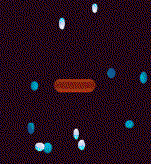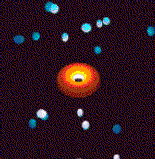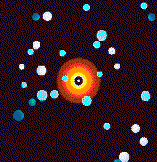The Unified Model of Active Galactic Nuclei
There are many different types of
AGN and broadly speaking, can be divided into groups according to the following
properties:
Radio power -
Radio-loud' AGN have very strong
radio emission when compared to the optical, whereas `radio-quiet' objects
have relatively little or no measurable radio flux.
Luminosity -
In low-luminosity objects, which
include Starburst Galaxies and Seyferts, the host galaxy can be seen around
the active nucleus. The more distant and energetic Quasars lie so far away
that the surrounding galaxy can no longer be seen, yet the nucleus is so
powerful that it outshines the galaxy and appears
`star-like' on the sky.
Optical spectral lines -
If `broad' spectral lines are seen
in the optical spectrum of an AGN, these indicate that we can see high-velocity
gas (moving at velocities between 1,000 and 10,000 km per second), presumably
from the broad line
region. These are known as `Type 1' AGN (eg Seyfert 1s and type
1 quasars). However if only `narrow' lines are observed, we are only seeing
low velocity gas from the
narrow
line region (between about 100 and 1,000 km per second), either because
the high velocity gas is obscured
(perhaps by the molecular
torus) or because it is simply not there. These are called `Type 2'
AGN.
The Unified Model -
Orientation of the Nucleus
The basic idea behind Unified Model
of AGN is that all of the AGN which we observe have the same internal structure
in their nucleus. All the differences that we see are caused by the angle
of the system (ie. the plane in which the accretion
disc , the outer parts of the broad
line region and the molecular
torus all lie).
 Type
2 objects - Seyfert 2s, Narrow Line Radio Galaxies and Type 2 Quasars:
Type
2 objects - Seyfert 2s, Narrow Line Radio Galaxies and Type 2 Quasars:
When we are looking
at the system edge-on (ie. along the plane of the disc), the central regions,
including the black hole, accretion disc and broad line region, are obscured.
All that we can see directly from the nucleus, are the molecular torus
(which radiates predominantly in the infra-red) and the emission lines
from the narrow line region. Thus when we look at the optical spectra,
only narrow lines are seen; there is no broad line emission. Light from
the nucleus can be reflected towards us by hot gas which lies above and
below the torus, and which acts as a kind of mirror. Observations like
this have demonstrated that `type 1' nuclei are hidden in `type 2' objects,
at least in some cases.
 Type
1 objects - Seyfert 1s, Broad Line Radio Galaxies and (Type 1) Quasars:
Type
1 objects - Seyfert 1s, Broad Line Radio Galaxies and (Type 1) Quasars:
As the nucleus `tips'
over towards us, we are able to see directly into the central regions.
Now we can see both broad and narrow lines in the optical spectrum, and
the direct emission from the accretion disc.
 Blazars
- BL Lac Objects and Optically-Violent Variables:
Blazars
- BL Lac Objects and Optically-Violent Variables:
These are a special
case of unobscured (type 1) objects where we are looking face-on at the
nucleus and directly into the jet. Matter in the jet is moving at velocities
close to the speed of light, so that the radiation it emits is beamed and
can vary wildly in very short periods of time (hours to days). Although
both broad and narrow lines are visible, the emission from the jet can
be so strong that it completely swamps any spectral lines: these are the
BL Lac objects. Optically-violent variables are similar to BL Lacs, but
emission lines are sometimes observed in their spectra.
This is a description of the basic
idea behind the Unified Model. It has been proposed that there are two
parallel sequences, one for radio-loud AGN where the radio jets are very
strong and extend into the surrounding galaxy, and another for the radio-quiet
AGN (where the radio emission is relatively weak). The pictures above illustrate
the radio-quiet case, principally because these dominate the AGN population
by a ratio of about 10 to 1, and because at present, they are the objects
on which we do the most research here at MSSL.
A description of some of our work
which is relevant to the Unified Model may be found in the section on the
Population Studies of AGN.
Other Extragalactic Astronomy pages:
 Return to the
MSSL Astrophysics Group Visitor Centre
Return to the
MSSL Astrophysics Group Visitor Centre
 Mullard Space Science Laboratory
Mullard Space Science Laboratory
Astrophysics Group
 Back to the
Mullard Space Science Laboratory homepage
Back to the
Mullard Space Science Laboratory homepage
This page last updated on the 11th September 1999.
www_astro@mssl.ucl.ac.uk
 Type
2 objects - Seyfert 2s, Narrow Line Radio Galaxies and Type 2 Quasars:
Type
2 objects - Seyfert 2s, Narrow Line Radio Galaxies and Type 2 Quasars: Type
1 objects - Seyfert 1s, Broad Line Radio Galaxies and (Type 1) Quasars:
Type
1 objects - Seyfert 1s, Broad Line Radio Galaxies and (Type 1) Quasars: Blazars
- BL Lac Objects and Optically-Violent Variables:
Blazars
- BL Lac Objects and Optically-Violent Variables: Return to the
MSSL Astrophysics Group Visitor Centre
Return to the
MSSL Astrophysics Group Visitor Centre Mullard Space Science Laboratory
Mullard Space Science Laboratory Back to the
Mullard Space Science Laboratory homepage
Back to the
Mullard Space Science Laboratory homepage